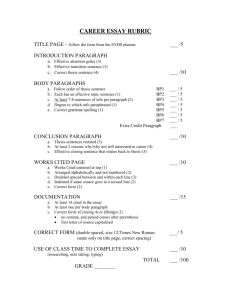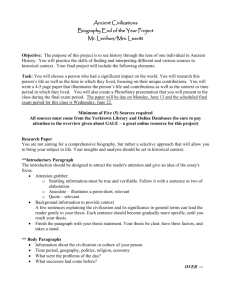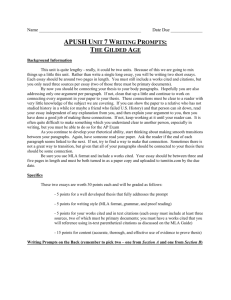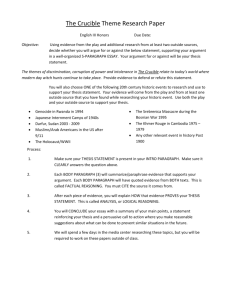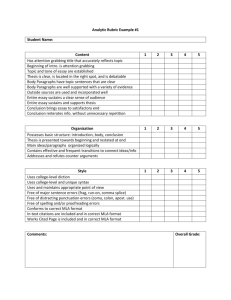global History Research Paper Directions.doc
advertisement
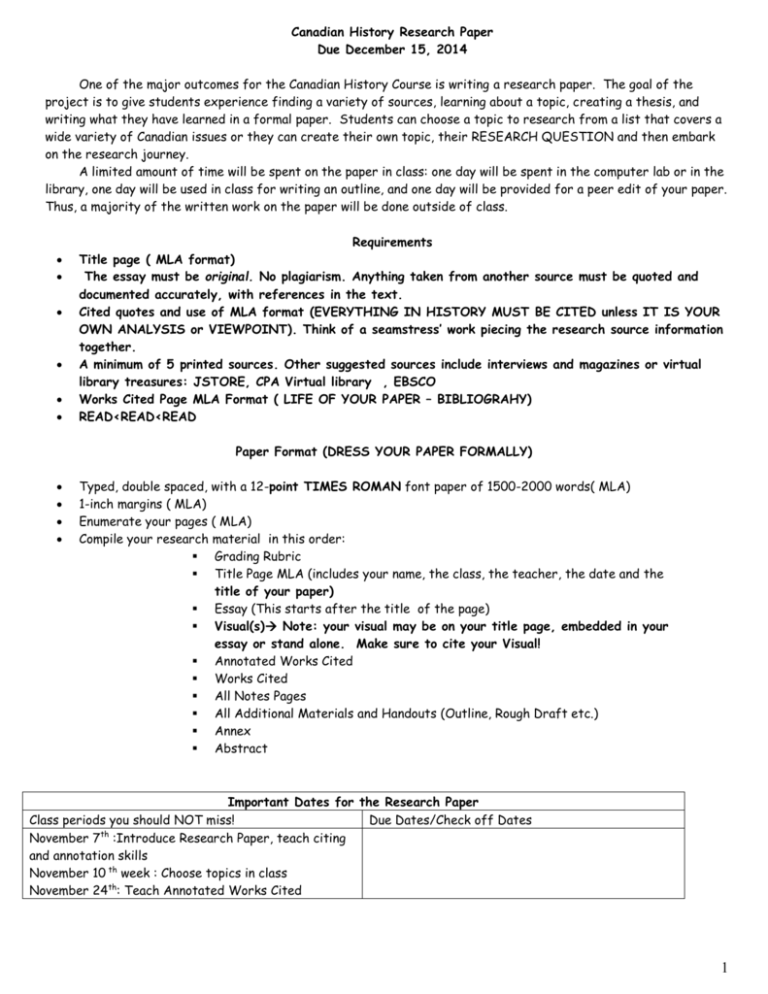
Canadian History Research Paper Due December 15, 2014 One of the major outcomes for the Canadian History Course is writing a research paper. The goal of the project is to give students experience finding a variety of sources, learning about a topic, creating a thesis, and writing what they have learned in a formal paper. Students can choose a topic to research from a list that covers a wide variety of Canadian issues or they can create their own topic, their RESEARCH QUESTION and then embark on the research journey. A limited amount of time will be spent on the paper in class: one day will be spent in the computer lab or in the library, one day will be used in class for writing an outline, and one day will be provided for a peer edit of your paper. Thus, a majority of the written work on the paper will be done outside of class. Requirements Title page ( MLA format) The essay must be original. No plagiarism. Anything taken from another source must be quoted and documented accurately, with references in the text. Cited quotes and use of MLA format (EVERYTHING IN HISTORY MUST BE CITED unless IT IS YOUR OWN ANALYSIS or VIEWPOINT). Think of a seamstress’ work piecing the research source information together. A minimum of 5 printed sources. Other suggested sources include interviews and magazines or virtual library treasures: JSTORE, CPA Virtual library , EBSCO Works Cited Page MLA Format ( LIFE OF YOUR PAPER – BIBLIOGRAHY) READ<READ<READ Paper Format (DRESS YOUR PAPER FORMALLY) Typed, double spaced, with a 12-point TIMES ROMAN font paper of 1500-2000 words( MLA) 1-inch margins ( MLA) Enumerate your pages ( MLA) Compile your research material in this order: Grading Rubric Title Page MLA (includes your name, the class, the teacher, the date and the title of your paper) Essay (This starts after the title of the page) Visual(s) Note: your visual may be on your title page, embedded in your essay or stand alone. Make sure to cite your Visual! Annotated Works Cited Works Cited All Notes Pages All Additional Materials and Handouts (Outline, Rough Draft etc.) Annex Abstract Important Dates for the Research Paper Class periods you should NOT miss! Due Dates/Check off Dates November 7th :Introduce Research Paper, teach citing and annotation skills November 10 th week : Choose topics in class November 24th: Teach Annotated Works Cited 1 Format/: Outline Due: December 7 th: Rough Draft DuePeer Editing in class December 15th : Final Essay Due100 points Signatures I have read the above information on the research paper and am aware of this assignment. Student Signature _______________________ Date____________________________________ Date____________________________________ Questions 1. Compare the Conservative Party of Macdonald, 1867-1891, to the Liberal Party of Laurier, 1896-1911. How were the two parties alike on the questions of French-English relations, Canada’s relationship with Britain, and trade policy? How did they differ? 2. Analyze the “National Policy” as a strategy for Canadian economic development. In what sense was it “national”? What were its political and economic strengths and weaknesses? 3. Do you see any similarities between Mitch Hepburn, Maurice Duplessis and William Aberhart, the premiers of Ontario, Quebec and Alberta during the 1930s? What would give this sort of man political appeal during a period of economic crisis? 4. “There was a dualism in Canada‘s foreign policy in the interwar period. On the one hand, Canada struggled for the right to be her own master; on the other hand, having gained that right, she refused to accept international obligations.” Discuss Canada‘s external relations, 1919-39, with this quotation as a starting point. 5. In 1958, John Diefenbaker was awarded the most overwhelming electoral majority in Canadian history, yet very quickly he became an almost pathetic figure, a living caricature. What caused this reversal? 6. Analyze the impact of regionalism on the Canadian federal system between 1878 and 1896. How did this regionalism express itself? 7. A noted historian has commented that Canada between 1867 and 1914 suffered not from a lack of nationalism, but from too much of two mutually exclusive nationalisms. Would you agree with his assessment? Give specific examples. 8. To what extent were the regional, social, and class conflicts of the period 1919- 1921 a product of problems created by the Great War, and to what extent were they conflicts fundamental to Canadian society? 9. Critically analyze the attempts (or lack of attempts) of the Bennett and King governments to solve the problem of depression, 1930-1939. 10. Discuss the negative and positive responses to immigration in early twentieth century Canada. Outline the reasons for these reactions and describe how they were manifested. 11. Discuss the appeal of imperialism in Canada in the late nineteenth and early twentieth centuries. Why did it fail to achieve any positive, long term results? 2 12. How did industrialization affect the lives of the Canadian working class? Assess the varying impact on men, women and children.. 13. Why was religion so closely connected to social reform in the late nineteenth and early twentieth centuries? Did this hinder or help the reformers? How? Why? 14. Was conscription a less divisive issue during World War II than in World War I? Compare the ways in which the federal government handled the issue in the two periods. 15. Why did the 1960s bring an increase in tensions between French and English Canada? 16. Why did the two world wars favour domestic reform in Canada? 17. Why have the native peoples emerged from obscurity since 1960? 18. Why have Canadian political leaders been so preoccupied with constitutional change since 1980? 19. “The women’s suffrage movement was not concerned with the liberation of females but with strengthening and extending their traditional roles.” Do you agree? 20. Explain Canada’s policy towards the aboriginals of the Northwest and the reactions of the native peoples to that policy, 1870-1900. 21. Sir John A. Macdonald may have been “drunk and dishonest” to quote one notable historian, but his leadership and policies were essential to the survival of Canada in its formative period. Do you agree or disagree? Why? 22. Many terms have been used to describe Louis Riel: visionary, rebel, Father of Confederation, criminal and traitor. Which of these do you feel is the most accurate? Why? 23. “Henri Bourassa was a brilliant critic and fervent nationalist. As a politician he was a complete failure.” Do you think this is a fair comment? Why? 24. Evaluate the career of Pierre Trudeau. Be sure to include an assessment of his economic policies as well as his handling of French-English relations during his tenure as Prime Minister. Was he a successful leader? 25. Account for the rise of the Parti Quebecois in the 1970s. What factors explain its success in 1976? What did the party accomplish once it had gained office? 3 Canadian History Research Project Name___________________________________ Notes from Source #1 Period ___ Date__________________________ Directions: Correctly cite your source below Citation of this source: ______________________________________________________________________________ ______________________________________________________________________________ ______________________________________________________________________________ Directions: Write a detailed annotation of your source. Refer back to your notes if you are unsure of how to do this! Annotation or Summary of this source: ______________________________________________________________________________ Directions: Take notes from your source in the space below. Make sure to use quotes around anything you copy directly and record the page numbers if it is from a book. Refer back to your note taking handout if you are unclear of how to take notes! Notes from this source: ______________________________________________________________________________ 4 Canadian History Research Paper Rubric 2013-2014 Student Name_______________________ Ms. Smith __________________ Criteria 1. Abstract ___________________5 2. Spelling and Grammar: 5 3. Thesis Paragraph: 15 Interesting grabber that clearly introduces time period/topic Sophisticated thesis statement with three clear reasons Essay map clearly presented and elaborates on thesis statement 4. Body Paragraphs: ( Quality of Evidence, Analysis, Synthesis) 65 Background Information Paragraph o Accurately and clearly explained to bring the reader up to speed on topic o Relevant and logical Reason #1 o o o Paragraph: ____10_____________ Clear supporting facts/details at least 4 proper in-text citations Info. thoroughly provides, with analysis, enough info. for reason #1 to support thesis o Sophisticated explanation of connection to thesis statement o Persuasive argument Reason #2 o o o o o Reason #3 o o o o o Paragraph:_______10____________ Clear supporting facts/details at least 4 proper in-text citations Info. thoroughly provides, with analysis, enough info. for reason #2 to support thesis. Sophisticated explanation of connection to thesis statement Persuasive argument Paragraph:_______10____________ Clear supporting facts/details at least 4 proper in-text citations Info. thoroughly provides, with analysis, enough info. for reason #3 to support thesis. Sophisticated explanation of connection to thesis statement Persuasive argument Concession Paragraph:_______ 10 Clearly acknowledges opposing point of view Dismisses alternative theses which effectively strengthens thesis At least 2 proper in-text citations Concluding Paragraph: ____5____ 5 Rephrases thesis and Summarizes main points Leaves the reader something new to think about 5. Overall Quality ____ 10 Writing reflects careful thought and analysis Demonstrates understanding of research question and historical issues Effective organization and superior flow Typed (12 point type)/ Times New Roman/1 inch margins on all sides/Doubled Spaced MLA Format 1500-2000 words 6. Works Cited Page ___ 10 Proper Format/Improper format Double space, alphabetical, indent second line At least 5 sources ( required 2 databases, 1 print) All citations are used at least once in paper Total Grade: __________/100 6
